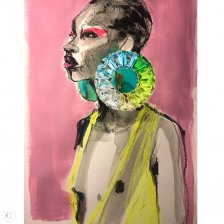PIECES OF PUZZLE COME TOGETHER IN INCREDIBLE MICROMOSAIC: MEET LE SIBILLE
In the Footsteps of the Sibyls
In ancient Greece, the Sibyls – or 'le Sibille' in Italian – were shrouded figures who whispered the will of the gods from hallowed sanctuaries. These veiled prophetesses, their words enigmatic and intoxicating, spun sacred stories from the threads of destiny.
Today, their voices echo through the labyrinth of time, the cryptic enchantments of the past winding through the tapestry of history.
A modern homage to this mystique emerges in Rome, where three master craftswomen have, since 1990, breathed life into the jewelry brand Le Sibille. Guardians of the ancient Small Roman Mosaic technique, and specialists in the venerable craft of goldsmithing, Le Sibille’s founders have forged an alchemical bond between antiquity and modern artisanship.
Three Modern Muses
Nestled in the heart of Rome, where cobblestones whisper tales of yore, Le Sibille is not merely a boutique: it is a portal through which history is reborn.
Camilla Bronzini, Francesca Neri Serneri, and Antonella Perugini, the trio of visionaries behind this venture, have taken up the mantle as modern-day muses. Their mission is to absorb the mosaic traditions of various cultures, marrying history, culture, and strong female figures in their creations. They weave fragments of history into one grand narrative, with each piece paying tribute to the female power to create and elevate.
The Mosaic in Time
The art of mosaic is steeped in history. Rome's artisans of the 1500s meticulously crafted altarpieces using this technique and, by the mid-1700s, micromosaics, with tiles as thin as 0.1 cm that allowed for detailed miniatures, were born in the Vatican Mosaic Studio.
Le Sibille employs these ancient techniques, seeking to resurrect a waning art form, evolved for the palate of contemporary wearers and jewelry connoisseurs.
An Ancient Alchemy Reborn
Micromosaic takes extraordinary patience: each tiny piece of the puzzle is placed by hand into the gold setting.
In their alchemical abode, Le Sibille's artists transform materials through fire and passion. This tapestry is woven from a concoction of silica, magnesium oxides, potassium, and calcium, merged into a paste, shaped into rods and threaded into tesserae at a searing 900–1000°C, to be later cut into miniature tiles using jewelry tongs. Later, deft hands meticulously place tiles, often smaller than one millimeter, onto an 18K gold base.
The Divine in the Material
For Le Sibille, jewels are fragments of the cosmos – talismans that anchor the wearer to spiritual and eternal energies. Mirroring the ancient Egyptians who, to honour the divine, adorned themselves with gold, Le Sibille creates heirlooms intended to be passed through the generations. They believe that the micromosaic tesserae embody earth, fire, water, and air – the fundamental elements that comprise the human experience.
Crafting with Conscience
Le Sibille is resolute in their commitment to ethical craftsmanship. The brand’s unwavering dedication to environmental sustainability and human rights ensures that their jewels are not only aesthetically enchanting but also woven with an ethical soul. From Japan’s rising sun to Europe’s ancient shores, Le Sibille’s commitment to excellence captivates a global audience.
Timeless Echoes
Every Monday at 6 pm CET, Le Sibille’s whispers reverberate across epochs via Instagram. Like the ancient prophetesses, Le Sibille picks up the pieces of an endless, colorful puzzle and channels messages that draw followers into a symphony of art, culture, and their efforts to preserve beauty from the tumultuous stream of time.
Wonderful paintings by Jacqueline Ostermann.
If jewelry were a restaurant in Italy, what would it be?
AROMA restaurant in Rome, on the Colosseum, next to the Domus Aurea. Its chef creates culinary jewels in perfect harmony with traditional Roman cuisine. The sunsets and colors of Rome rediscover, like mosaic tiles, the assonance of the preciousness of our jewels.
A book to read in the summertime?
MIRABILIS by Ersilia Vaudo: a scientific and poetic book, which tells how man, piece by piece, has lost all illusion of centrality. A journey into the very deep cosmos as we understood it after the theory of relativity: nothing more uprooting, nothing more intoxicating!
A book to read before bed?
THE COURAGE TO BE DISLIKED by Ichiro Kishimi and Fumitake Koga, about being freed from others' judgement and finding authentic happiness.
A place to have a good time with your best friend in Italy?
Thermal Baths of San Casciano, Tuscany; Procida, Palazzo Merulana; the Botanical Gardens of Rome in Trastevere.
A place to be on your own, for some precious me time? (Whether in Italy or anywhere in the world.)
An island: Ventotene, Alicudi, Stromboli; Amalfi coast or Greece; Folegandros.
A gallery, a place to enjoy art in Italy?
Modern art gallery Viale delle Belle Arti, MAXXI (museum of contemporary art and architecture), Contemporary Cluster art gallery, Gagosian Gallery – all in Rome.
А person?
Frida Kahlo: innovative, borderline, heart/flowers woman, enlightened and a great healer.







